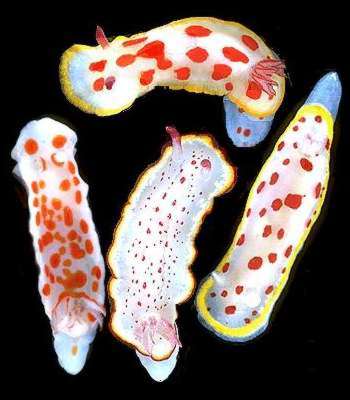
Mimicry - red-spotted chromodorids
PHOTO
Top: Chromodoris splendida. Lower left: Chromodoris tasmaniensis. Lower centre: Chromodoris daphne. Lower right: Chromodoris hunterae.
PHOTOS: Bill Rudman.
RELATED TOPIC
There are many examples of animals which have evolved to look almost identical to another animal. Have a look at the mimicry page for further information.
In south eastern Australia many of the species of chromodorid found there are found nowhere else, and there is a group of species which all have a red-spotted colour pattern. We think this mimicry has evolved so that potential predators, such as fish, learn more quickly that red spots are a sign that the animal has large glands of distasteful chemicals in their mantle. Chromodorids all have mantle glands which contain chemicals that are distasteful to fish. The chemicals are from the sponges they feed on. When poisonous animals have warning colours like this we call it aposematic colouration.
References:
• Rudman, W.B. (1991) Purpose in Pattern: the evolution of colour in chromodorid nudibranchs.Journal of Molluscan Studies, 57, (T.E. Thompson Memorial Issue): 5-21.
Rudman, W.B., 2004 (July 23) Mimicry - red-spotted chromodorids. [In] Sea Slug Forum. Australian Museum, Sydney. Available from http://www.seaslugforum.net/find/redspot
Related messages
Two more SE Australian endemics
June 3, 1999
From: Bill Rudman
Here are two more red-spotted southeastern Australian endemics that I forgot to add to the list I posted a couple of days ago.
Chromodoris loringi
Chromodoris thompsoni.
As I said then, this is not them all.
Best wishes,
Bill Rudman
Endemic SE Australian chromodorids
June 1, 1999
From: Austin
Dear Dr. Rudman:
Hi, this is Austin again.
I just want to tell you again how much I love the Sea Slug Forum. Something divine in the diversity and quality of image representation. I just feel this inspiring passion to understand them. I remember holding the large peach-colored Tritonia from the Pacific-Northwest United States. One would shake his moustached head back and forth. Several of them had mutations, as the place from which they were collected near Seattle had been at one time an industrial effluent area. And I want to learn to protect them from Man's proclivity for habitat destruction. Public awareness seems a wonderful start.
On one of the Hypselodoris posts, there was a mention of a 1999 Gosliner publication about Hypselodoris. Would you by chance have that reference?
__________________
I've been reading your J. Moll. Stud. "Purpose in Pattern: the Evolution of colour in chromodorid nudibranchs" and am looking to put together photos of color groups for my own visual comparison. I have the drawing set in Figure 1, but it's photocopied and thus without color. I was wondering if you have :
A PHOTO of H. bennetti?
Or PHOTOs of Chromodoris fidelis (22) and Noumea haliclona (40) diagrammed in Figure 2?
Or PHOTOS of
Digidentis perplexa (41),
Chromodoris ambiguus (49) or C. alternata (53) from Figure 4?
Thanks,
Austin.
jaustin@bio.fsu.edu
Austin, 1999 (Jun 1) Endemic SE Australian chromodorids. [Message in] Sea Slug Forum. Australian Museum, Sydney. Available from http://www.seaslugforum.net/find/901Dear Austin,
Thanks for your kind words about the Forum. Sorry I'm a bit slow replying but I decided it was time to post pictures of some of the southeastern Australian endemics you were asking about. I have listed them in a separate message posted today. I'm afraid Noumea haliclona will have to wait as it is a complex of colour morphs, some of which occur together and others which are restricted to discrete geographic regions.
Concerning the Hypselodoris paper. I have been meaning to sing the praises of this major work but I'm afraid I never seem to have enough time in the day. It is an exhaustive review of the genus, describing a number of new species. I wish all taxonomic studies were so comprehensive and easy to follow. Congratulations to Terry Gosliner and Rebecca Johnson.
Gosliner, T.M. & Johnson, R.F. (1999). Phylogeny of Hypselodoris (Nudibranchia: Chromodorididae) with a review of the monophyletic clade of Indo-Pacific species, including the descriptions of twelve new species. Zoological Journal of the Linnean Society, 125: 1-114.
Best wishes,
Bill Rudman.
Ten SE Australian endemic chromodorids
June 1, 1999
From: Bill Rudman
In response to Austin's message, here are some endemic chromodorids from southeastern Australia. I will gradually put up some more species but these should give you an idea of some of the mimicry that is occurring in the region.
Chromodoris fidelis
Chromodoris fidelis (spotted form)
Chromodoris alternata
Chromodoris ambiguus
Digidentis perplexa
Hypselodoris bennetti
Chromodoris woodwardae
Chromodoris hunterae
Chromodoris daphne
Chromodoris splendida
Bill Rudman.
